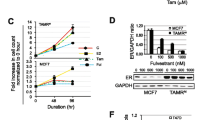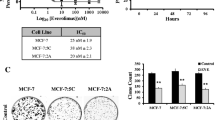Abstract
Resistance to aromatase inhibitors (AIs) involves increased HER2. One mechanism by which HER2 may mediate resistance is through expansion of the tumor initiating cell (TIC) population. This study investigates whether combining all-trans retinoic acid (ATRA) and histone deacetylase inhibitor entinostat (ENT) can inhibit TICs and HER2 in AI-resistant cells and tumors. Modulation of cell viability and HER2 expression were assessed in AI-resistant cells treated with ATRA + ENT. Letrozole-resistant LTLT-Ca cells treated with ATRA + ENT were assayed for changes in TIC characteristics, such as TIC markers (BCRP, ALDH, and BMI-1), side population (SP), and mammosphere formation. Xenograft tumors of MCF-7Ca cells made resistant to letrozole were treated with ATRA, ATRA + letrozole, ATRA + ENT, or ATRA + ENT + letrozole. Resulting tumors were assayed for changes in TIC characteristics. Patient samples taken pre- and post-AI treatment were analyzed for changes in ERα and HER2 protein expression. Treatment with ATRA + ENT reduced HER2 expression and viability (P < 0.001) in AI-resistant cells, as well as decreased SP (P < 0.0001), mammosphere formation (P < 0.01), and expression of TIC molecular markers (P < 0.01) in LTLT-Ca. A reduction in tumor growth rate was observed in mice treated with ENT + ATRA + letrozole when compared to mice treated with single agents (P < 0.0001) or ENT + ATRA (P = 0.02). Decreased TIC characteristics, including mammosphere formation (P < 0.05), were observed in tumors from the triple combination. An increase in HER2 and downregulation in ERα protein expression was observed in patients upon resistance to AI (P < 0.005). These studies indicate that the combination of ATRA and ENT inhibits the TIC population of AI-resistant cells and may be effective in reducing tumor recurrence.





Similar content being viewed by others
Abbreviations
- AI:
-
Aromatase inhibitor
- ERα:
-
Estrogen receptor-alpha
- HER2:
-
Human epidermal growth factor-2
- TIC:
-
Tumor initiating cells
- ALDH:
-
Aldehyde dehydrogenase
- SP:
-
Side population
- ENT:
-
Entinostat
- HDAC:
-
Histone deacetylase
- BCRP:
-
Breast cancer resistance protein
- ATRA:
-
All-trans retinoic acid
- Δ4A:
-
3,17-Androstenedione
References
Zhou DJ, Pompon D, Chen SA (1990) Stable expression of human aromatase complementary DNA in mammalian cells: a useful system for aromatase inhibitor screening. Cancer Res 50:6949–6954
Jelovac D, Sabnis G, Long BJ et al (2005) Activation of mitogen-activated protein kinase in xenografts and cells during prolonged treatment with aromatase inhibitor letrozole. Cancer Res 65:5380–5389
Johnston SR, Head J, Pancholi S et al (2003) Integration of signal transduction inhibitors with endocrine therapy: an approach to overcoming hormone resistance in breast cancer. Clin Cancer Res 9:524S–532S
Howell A, Cuzick J, Baum M et al (2005) Results of the ATAC (Arimidex, Tamoxifen, Alone or in Combination) trial after completion of 5 years’ adjuvant treatment for breast cancer. Lancet 365:60–62
Nakanishi T, Chumsri S, Khakpour N et al (2010) Side-population cells in luminal-type breast cancer have tumour-initiating cell properties, and are regulated by HER2 expression and signalling. Br J Cancer 102:815–826. doi:10.1038/sj.bjc.6605553
Sabnis GJ, Kazi A, Golubeva O et al (2013) Effect of selumetinib on the growth of anastrozole-resistant tumors. Breast Cancer Res Treat 138:699–708. doi:10.1007/s10549-013-2474-5
Gilani RA, Kazi AA, Shah P et al (2012) The importance of HER2 signaling in the tumor-initiating cell population in aromatase inhibitor-resistant breast cancer. Breast Cancer Res Treat 135:681–692. doi:10.1007/s10549-012-2148-8
Sabnis GJ, Goloubeva OG, Kazi AA et al (2013) HDAC inhibitor entinostat restores responsiveness of letrozole-resistant MCF-7Ca xenografts to aromatase inhibitors through modulation of Her-2. Mol Cancer Ther 12:2804–2816. doi:10.1158/1535-7163.MCT-13-0345
Chang Q, Chen Z, You J et al (2007) All-trans-retinoic acid induces cell growth arrest in a human medulloblastoma cell line. J Neurooncol 84:263–267. doi:10.1007/s11060-007-9380-9
Guo JM, Xiao BX, Lou YR et al (2006) The effects of all-trans-retinoic acid on cell cycle and alkaline phosphatase activity in pancreatic cancer cells. Med Chem 2:457–461
Rodriguez A, Diez C, Caamano JN et al (2007) Retinoid receptor-specific agonists regulate bovine in vitro early embryonic development, differentiation and expression of genes related to cell cycle arrest and apoptosis. Theriogenology 68:1118–1127
Schech AJ, Nemieboka BE, Brodie AH (2012) Zoledronic acid inhibits aromatase activity and phosphorylation: potential mechanism for additive zoledronic acid and letrozole drug interaction. J Steroid Biochem Mol Biol 132:195–202. doi:10.1016/j.jsbmb.2012.05.008
Schech AJ, Kazi AA, Gilani RA et al (2013) Zoledronic acid reverses the epithelial-mesenchymal transition and inhibits self-renewal of breast cancer cells through inactivation of NF-kappaB. Mol Cancer Ther 12:1356–1366. doi:10.1158/1535-7163.MCT-12-0304
Sabnis G, Schayowitz A, Goloubeva O et al (2009) Trastuzumab reverses letrozole resistance and amplifies the sensitivity of breast cancer cells to estrogen. Cancer Res 69:1416–1428. doi:10.1158/0008-5472.CAN-08-0857
Dontu G, Abdallah WM, Foley JM et al (2003) In vitro propagation and transcriptional profiling of human mammary stem/progenitor cells. Genes Dev 17:1253–1270. doi:10.1101/gad.1061803
Korkaya H, Paulson A, Iovino F et al (2008) HER2 regulates the mammary stem/progenitor cell population driving tumorigenesis and invasion. Oncogene 27:6120–6130. doi:10.1038/onc.2008.207
Jin J, Li X, Xing L et al (2015) Addition of all-trans-retinoic acid to omeprazole and sucralfate therapy improves the prognosis of gastric dysplasia. J Int Med Res 43:204–216. doi:10.1177/0300060514559791
Grunt T, Dittrich E, Offterdinger M et al (1998) Effects of retinoic acid and fenretinide on the c-erbB-2 expression, growth and cisplatin sensitivity of breast cancer cells. Br J Cancer 78:79–87
Diessner J, Bruttel V, Stein RG et al (2014) Targeting of preexisting and induced breast cancer stem cells with trastuzumab and trastuzumab emtansine (T-DM1). Cell Death Dis 5:e1149. doi:10.1038/cddis.2014.115
Ithimakin S, Day KC, Malik F et al (2013) HER2 drives luminal breast cancer stem cells in the absence of HER2 amplification: implications for efficacy of adjuvant trastuzumab. Cancer Res 73:1635–1646. doi:10.1158/0008-5472.CAN-12-3349
Arisi MF, Starker RA, Addya S et al (2014) All trans-retinoic acid (ATRA) induces re-differentiation of early transformed breast epithelial cells. Int J Oncol 44:1831–1842. doi:10.3892/ijo.2014.2354
Bhat-Nakshatri P, Goswami CP, Badve S et al (2013) Identification of FDA-approved drugs targeting breast cancer stem cells along with biomarkers of sensitivity. Sci Rep 3:2530. doi:10.1038/srep02530
Blagitko-Dorfs N, Jiang Y, Duque-Afonso J et al (2013) Epigenetic priming of AML blasts for all-trans retinoic acid-induced differentiation by the HDAC class-I selective inhibitor entinostat. PLoS One 8:e75258. doi:10.1371/journal.pone.0075258
Pili R, Salumbides B, Zhao M et al (2012) Phase I study of the histone deacetylase inhibitor entinostat in combination with 13-cis retinoic acid in patients with solid tumours. Br J Cancer 106:77–84. doi:10.1038/bjc.2011.527
Arnedos M, Drury S, Afentakis M et al (2014) Biomarker changes associated with the development of resistance to aromatase inhibitors (AIs) in estrogen receptor-positive breast cancer. Ann Oncol 25:605–610. doi:10.1093/annonc/mdt575
Acknowledgments
This work was supported by grants to G Sabnis (KG10037 from Susan G Komen), A Kazi (BC1039031 from Department of Defense Breast Cancer Research Program) and to A Brodie (CA-62483 from NCI/NIH and SAC100010 from Susan G Komen). The authors would like to thank the University of Maryland School of Medicine Flow Core for their assistance.
Conflict of interest
The authors declare that they have no conflict of interest.
Author information
Authors and Affiliations
Corresponding author
Electronic supplementary material
Below is the link to the electronic supplementary material.
Rights and permissions
About this article
Cite this article
Schech, A.J., Shah, P., Yu, S. et al. Histone deacetylase inhibitor entinostat in combination with a retinoid downregulates HER2 and reduces the tumor initiating cell population in aromatase inhibitor-resistant breast cancer. Breast Cancer Res Treat 152, 499–508 (2015). https://doi.org/10.1007/s10549-015-3442-z
Received:
Accepted:
Published:
Issue Date:
DOI: https://doi.org/10.1007/s10549-015-3442-z




